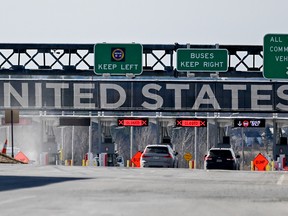Top Stories
Surge in Asylum Seekers at Quebec Border Attributed to U.S. Policies

Canada is experiencing a significant increase in the number of asylum seekers crossing its border from the United States, particularly through the Saint-Bernard-de-Lacolle border crossing in Quebec. Since the beginning of July, Canadian authorities have processed over 5,500 asylum claims at this crossing, marking a striking 263 percent increase compared to the same timeframe last year, according to data from the Canada Border Services Agency.
This rise in asylum claims highlights the impact of U.S. immigration policies under President Donald Trump. His administration’s hardline stance has prompted many migrants, including U.S. citizens, to reconsider their options. This summer’s surge underscores how the policies in the U.S. are influencing migration patterns beyond its borders.
The Saint-Bernard-de-Lacolle crossing, located just south of Montreal and approximately six hours north of New York City, has become a primary entry point for individuals seeking refuge in Canada. Although the area has historically been a popular route for migrants, recent changes in U.S.-Canada agreements have made it more challenging for individuals to claim asylum if they cross through unofficial channels.
According to Aisling Bondy, president of the Canadian Association of Refugee Lawyers, the increased activity is likely due to undocumented individuals who have lived in the U.S. for extended periods feeling uncertain about their safety. Many of those arriving in Canada may find it difficult to gain asylum without demonstrating close family ties in the country.
As of mid-September, there have been 2,272 cases this year where individuals were deemed ineligible for refugee status under the Safe Third Country Agreement and subsequently returned to the U.S. This treaty mandates that foreign nationals must seek asylum in the first safe country they enter, which complicates the process for many.
The current wave of asylum seekers includes a significant number of Haitians, who represent the largest group arriving in Quebec. Following them are U.S. citizens, particularly children born to undocumented parents. These American-born children are eligible to claim refugee status in Canada, although they face a complicated bureaucratic landscape.
While the number of asylum claims has risen sharply at land border crossings, overall asylum claims across Canada have increased by 30 percent in the first half of the year. This increase contrasts with a decline in claims at airports, primarily due to stricter entry requirements for migrants.
U.S. Customs and Border Protection has not provided comments regarding these developments. However, the Royal Canadian Mounted Police has acknowledged a notable rise in illegal border crossings, particularly in Quebec. The RCMP has intensified its efforts, deploying additional resources, including two Black Hawk helicopters, to address the situation and improve border security.
As the situation evolves, both Canadian and U.S. authorities continue to collaborate on border security measures. Surveillance systems operate in tandem to monitor crossings, with RCMP officers utilizing cameras to detect unauthorized movements. Despite these efforts, many individuals seeking asylum find themselves vulnerable, often falling victim to smugglers who exploit their desperate circumstances.
Experts warn that crossing the border without proper channels can lead to significant challenges. Bjorna Shkurti, an immigration lawyer based in Calgary, cautions U.S. citizens considering asylum in Canada that the success rate for such claims has historically been low. The current political climate in the U.S. adds to the apprehension many feel about approaching Canadian ports of entry.
As conditions at the border continue to shift, the dynamics of migration between the U.S. and Canada are being closely monitored. The increasing number of asylum seekers highlights the broader implications of U.S. immigration policies and their effects on individuals seeking safety and stability in Canada.
-

 Science2 months ago
Science2 months agoToyoake City Proposes Daily Two-Hour Smartphone Use Limit
-

 Health2 months ago
Health2 months agoB.C. Review Reveals Urgent Need for Rare-Disease Drug Reforms
-

 Top Stories2 months ago
Top Stories2 months agoPedestrian Fatally Injured in Esquimalt Collision on August 14
-

 Technology2 months ago
Technology2 months agoDark Adventure Game “Bye Sweet Carole” Set for October Release
-

 World2 months ago
World2 months agoJimmy Lai’s Defense Challenges Charges Under National Security Law
-

 Technology2 months ago
Technology2 months agoKonami Revives Iconic Metal Gear Solid Delta Ahead of Release
-

 Technology2 months ago
Technology2 months agoSnapmaker U1 Color 3D Printer Redefines Speed and Sustainability
-

 Technology2 months ago
Technology2 months agoAION Folding Knife: Redefining EDC Design with Premium Materials
-

 Technology2 months ago
Technology2 months agoSolve Today’s Wordle Challenge: Hints and Answer for August 19
-

 Business2 months ago
Business2 months agoGordon Murray Automotive Unveils S1 LM and Le Mans GTR at Monterey
-

 Lifestyle2 months ago
Lifestyle2 months agoVictoria’s Pop-Up Shop Shines Light on B.C.’s Wolf Cull
-

 Technology2 months ago
Technology2 months agoApple Expands Self-Service Repair Program to Canada









